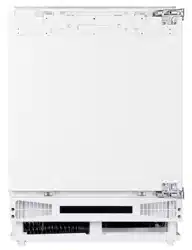Loading ...
Loading ...
Loading ...

a)
b)
c)
d)
e)
Preserves
pastries, ready cooked foods
Dairy produce / meats and
sausages
Meats and sausages
Vegetables, fruits,
salad
Advice
prevent odours from building up inside. If your appliance has
a lock, set the lock in the “closed” position with the doors
open and keep the key well away from small children to
prevent accidents.
Ice and frost layers which build up to a certain thickness on
the inside walls, act as insulation and prevent the dispersion
of the coldness. These must be removed from time to time.
To remove the layers of ice from the inside walls, use a
plastic or wood scraper with no sharp edges.
When doing this, remove the drawers and lay a cloth on the
bottom of the appliance to catch the ice as it is scraped off so
that it can be easily removed.
The method least likely to damage your appliance when
removing the layers of ice is to defrost it.
Defrosting (Not applicable for NO FROST devices)
In normal circumstances (opening the freezer 4 – 5 times a
day), the freezer compartment should be defrosted once or
twice a year (more often in other circumstances).
The fridge compartment is defrosted automatically.
Danger warnings
• Never use electrical appliances to defrost your appliance,
such as a hair dryer, fan heater, dehumidifiers, de-icing
sprays or anything with a naked flame (e.g. candles).
• The plastic inside of your appliance could melt and the
escaping gas or foam could be ignited by sparks or by the
naked flame.
• On no account should a steam-cleaning device be
used to defrost the layers of ice in the appliance
(great risk of an electric shock).
Proceed as follows to defrost your appliance:
1. Provide a suitable non-metallic container (a plastic
container or wash-basket).
2. Make sure that you remove the plug from the power
socket.
3. Dry your hands thoroughly to prevent skin damage from
contact with ice
(It is advisable to use gloves).
4. Remove all frozen food from the freezer and roll it firmly
in newspaper place it in the container already prepared
and place the container in a cool, dry room.
5. Cover the container all around with a thick blanket.
6. Remove the drawers by pulling them as far out as
possible and then raising them slightly.
7. As described previously, scrape the thickest ice carefully
from inside the freezer and put it in the kitchen sink.
8. If your appliance is equipped with a drip duct at the
bottom of the appliance, pull it out and place a bowl to
catch the dripping water underneath it.
9. If necessary, speed up defrosting by placing a large bowl
of warm (not too hot) water on the bottom of the
appliance and close the door.
10. If your appliance is not equipped with a drip duct, place
an absorbent cloth underneath the front of the appliance
and wipe up the defrosting water with a sponge.
11. Thoroughly clean the inside. Wipe it out with warm water
and a little vinegar and then rinse it out with clear water.
12. Dry it thoroughly with a soft cloth and air it for 3-4 minutes.
13. Close the door and plug the appliance back in.
14. Reset the temperature dial to the maximum setting.
(If your appliance is equipped with green and red
pilot lights, these will come on) and if the SUPER
FREEZE SWITCH is provided, switch it on .
15. Now refill the drawers with the frozen food - the oldest
items at the top.
To prevent the frozen food from defrosting, carry out the
steps described above within two hours at the most.
16. When the red pilot light goes off, reset the temperature
dial to a medium setting.
If provided, switch off the SUPER FREEZE SWITCH
after about 12, but no later than 24 hours.
11
Changing the light bulb:
Under no circumstances should you use a lamp with a
wattage greater than that specified on the original lamp.
This product contains a light source of energy
efficiency class G.
LED lights may only be replaced by a qualified
specialist.
In general, no warranty is given on lamps.
Temperature settings:
The temperature must be set according to:
• room temperature
• quantity of stored food
• how often the appliance is opened
We recommend a medium setting. You will soon learn,
through observation, which is the most suitable setting for
your requirements.
Interior lighting (not available on all models)
For those models equipped with interior lighting, a
Switch has been built in.
When the appliance has been switched on at the
temperature dial, the light automatically comes on when the
fridge door is opened and automatically goes off when the
door is closed.
The light bulb is protected by a transparent cover.
Temperature range
Thanks to the natural air circulation in the fridge
compartment there is a range of differing temperatures that
is suitable for the storage of different food. The coldest
areas are directly over the salad crispers, in the lowest part
of the fridge and against the back wall (suitable e.g. for
sausages and meats); the warmest areas are in the front
upper part and on the door (suitable for spread able butter
and cheese).
Arrange the food according to the following table and store it
not too tightly packed so that the air can circulate freely.
Storing food in the fridge (from the top to the bottom)
1. Door storage compartments
a) Butter, cheese
b) Eggs
c) Small jars or bottles, tins, seasonings
d) Large bottles, tins
2. Fridge compartment (shelving / glass plates)
7
Loading ...
Loading ...
Loading ...
